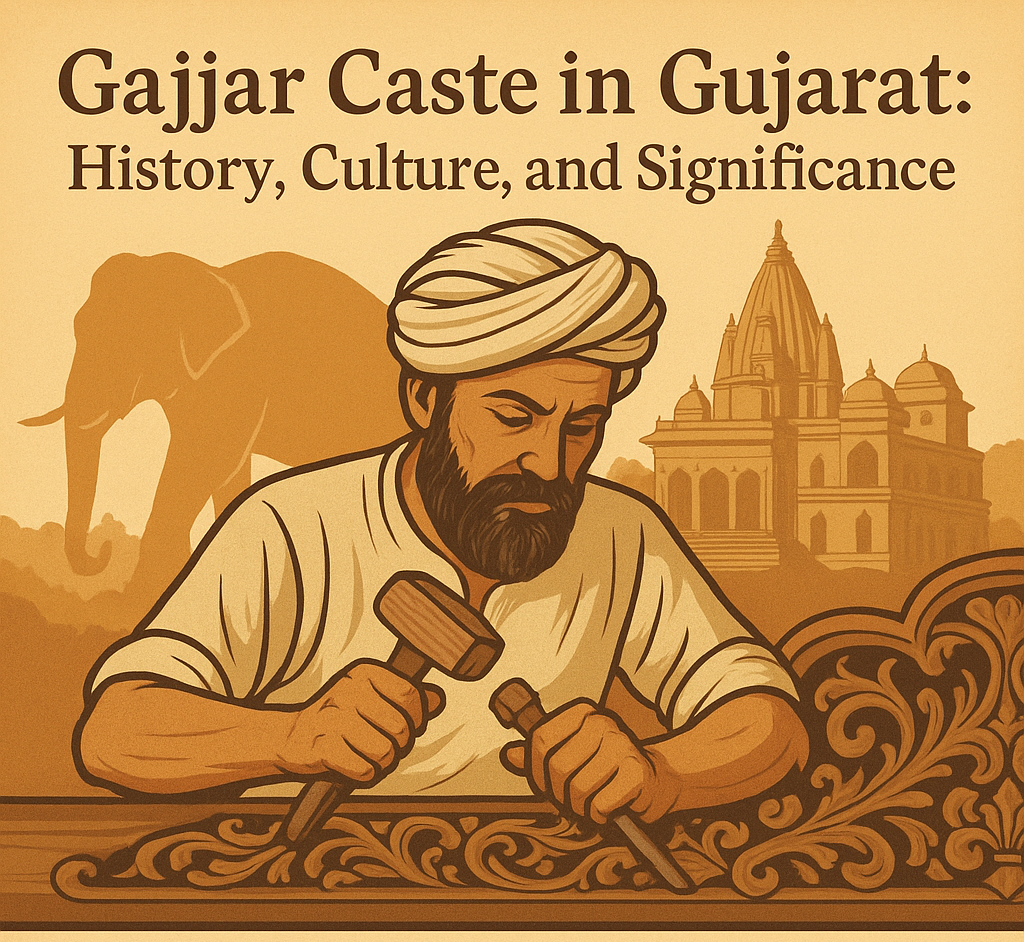Blog
Gajjar Caste in Gujarat : History, Culture, and Significance

Gajjar Caste in Gujarat: History, Culture, and Significance
Introduction
Gajjar Caste in Gujarat :The Gajjar caste forms a vital part of Gujarat’s rich cultural and social framework. Belonging to the Vishwakarma community, Gajjars, primarily from the Suthar sub-caste, excel in carpentry, craftsmanship, and related artisanal skills. This article delves into their origins, historical contributions, cultural significance, and modern-day relevance in Gujarat. Optimized for SEO, it provides in-depth insights into the Gajjar caste’s role in shaping Gujarati heritage and caste dynamics, appealing to readers interested in regional history and social structures.
Origins of the Gajjar Caste
The Gajjar surname derives from the Gujarati word “Gaj,” rooted in Sanskrit, meaning “elephant” or “measuring tape.” This term reflects precision-based occupations, such as carpentry, construction, and civil engineering. Gajjars belong to the Suthar community, a sub-group of the Vishwakarma caste, which reveres Lord Vishwakarma, the divine architect in Hindu mythology. Their expertise in woodworking, architecture, and craftsmanship has made them indispensable to Gujarat’s socio-economic fabric. The surname also hints at roles in land measurement or structural design, underscoring their technical proficiency.
Gajjars thrive in urban centers like Rajkot, Ahmedabad, Surat, Navsari, and Vapi. Their presence extends globally, with significant diaspora communities in Mumbai, Pune, East Africa, the United Kingdom, and the United States. These communities maintain strong cultural ties to Gujarat, contributing to the global spread of Gujarati traditions. The Gajjar caste’s identity is deeply tied to their artisanal heritage, which continues to influence their social and professional roles.
Historical Significance
From the 1500s to the 1900s, Gajjars played a pivotal role in Gujarat’s development. They served on village business committees, overseeing construction projects and craftsmanship. Their carpentry and engineering skills shaped temples, homes, and public buildings, leaving a lasting architectural legacy. Their work often required collaboration with other artisan groups, fostering community cohesion.
A prominent figure, Tribhuvandas K. Gajjar, emerged as a trailblazer in the late 19th and early 20th centuries. Born into a wealthy carpenter family in Surat, he founded Kala Bhavan, a polytechnic in Baroda, under the patronage of Maharaja Sayajirao Gaekwad. He introduced synthetic dyes to India’s textile industry, revolutionizing production methods. His establishment of dyeing schools across India empowered artisans with modern techniques. At Kala Bhavan, 41% of students came from artisan castes, including farmers and cultivators, promoting inclusive education. His chemical expertise also led to the restoration of Queen Victoria’s marble statue in Bombay, a testament to his versatility.
Tribhuvandas Gajjar’s advocacy for vernacular education further distinguished him. He founded the Vernacular Academy, emphasizing learning in the mother tongue to make education accessible. His contributions highlight the Gajjar caste’s commitment to innovation and social progress, extending beyond traditional craftsmanship.
Cultural Contributions
Gajjars, as part of the Suthar and Vishwakarma communities, have enriched Gujarat’s cultural landscape through their craftsmanship. They craft intricate woodwork for traditional Gujarati homes, havelis, and temples, showcasing aesthetic and technical mastery. Their work often features detailed carvings, reflecting Gujarat’s artistic heritage. The community’s reverence for Lord Vishwakarma strengthens their spiritual connection to their craft. They celebrate Vishwakarma Jayanti with enthusiasm, honoring their patron deity through rituals and community gatherings.
Beyond physical craftsmanship, Gajjars have advanced education and cultural preservation. Tribhuvandas Gajjar’s establishment of Kala Bhavan and the Vernacular Academy set a precedent for intellectual growth within artisan communities. These institutions provided practical training, enabling artisans to adapt to modern demands while preserving traditional skills. The Gajjar diaspora plays a crucial role in maintaining Gujarati culture abroad. In regions like East Africa, the UK, and North America, Gajjars organize cultural events, festivals, and religious ceremonies, fostering a sense of identity and community.
The community’s culinary contributions also deserve mention. Gajjars, like many Gujarati communities, adhere to vegetarianism, influenced by Jain and Hindu traditions. Their cuisine features staples like dhokla, thepla, and undhiyu, often shared during festivals and family gatherings. These dishes reflect Gujarat’s culinary diversity and the Gajjar caste’s role in preserving regional flavors.
Gajjar vs. Gurjar: Clarifying the Distinction
The similarity between the names Gajjar and Gurjar often causes confusion. Gurjars, an agricultural and pastoral ethnic group, trace their history to the Gurjara-Pratihara dynasty (6th to 11th centuries). They primarily reside in Rajasthan, Gujarat, and northern India, with a heritage tied to farming and warrior traditions. Some scholars link Gurjars to Central Asian migrations or the Hephthalites, though their origins remain debated.
In contrast, Gajjars belong to the Suthar community within the Vishwakarma caste, focusing on artisanal professions like carpentry and engineering. Their identity centers on technical expertise rather than agricultural or martial roles. This distinction clarifies the Gajjar caste’s unique place in Gujarat’s social structure, emphasizing their contributions to craftsmanship and innovation.
Socio-Economic Status and Modern Relevance
In modern India, Gajjars are classified as Other Backward Classes (OBC) in some states, reflecting historical marginalization despite their skilled contributions. However, the community has achieved significant socio-economic mobility. Gajjars excel in diverse fields, including business, education, and public service. Dinesh Gajjar, a prominent figure in the diamond industry, exemplifies their success in global markets. Heeralal Gajjar, an educator, works to improve access to quality education, continuing the community’s legacy of social impact.
The Gajjar diaspora has further elevated the community’s status. Migration during the British colonial period to East Africa, the UK, and North America created vibrant communities that maintain cultural practices. They celebrate festivals like Diwali, Navratri, and Vishwakarma Jayanti, reinforcing their Gujarati identity. Worship of deities like Lord Vishwakarma and Vishnu remains central to their spiritual life, with community temples serving as cultural hubs.
Gajjars have also embraced modern professions, including engineering, IT, and entrepreneurship. Their traditional skills in precision and design translate well into fields like civil engineering and architecture. The community’s adaptability ensures their relevance in a rapidly changing world, balancing heritage with innovation.
Community Organization and Social Structure
The Gajjar caste maintains a strong sense of community through organized social structures. In Gujarat, they form associations like the Gajjar Suthar Samaj, which facilitates cultural events, marriages, and charitable activities. These organizations provide support for education, healthcare, and economic opportunities, strengthening community bonds. In the diaspora, similar associations exist, connecting Gajjars across continents and promoting cultural preservation.
Marriage within the Gajjar caste often follows traditional practices, with families prioritizing alliances within the Suthar or Vishwakarma communities. These unions reinforce social ties and shared values. However, younger generations increasingly embrace inter-caste marriages, reflecting broader societal changes in India.
Challenges and Opportunities
Despite their achievements, Gajjars face challenges. Their OBC status in some states highlights systemic barriers to equal opportunities. Access to quality education and healthcare remains a concern for some community members, particularly in rural areas. However, initiatives like scholarships and skill development programs, often supported by community organizations, address these issues.
Opportunities abound for Gajjars in the modern economy. Their traditional skills align with growing industries like sustainable architecture and eco-friendly design. The global demand for skilled artisans and engineers positions Gajjars for continued success. Additionally, their diaspora networks facilitate international business ventures, enhancing economic prospects.








